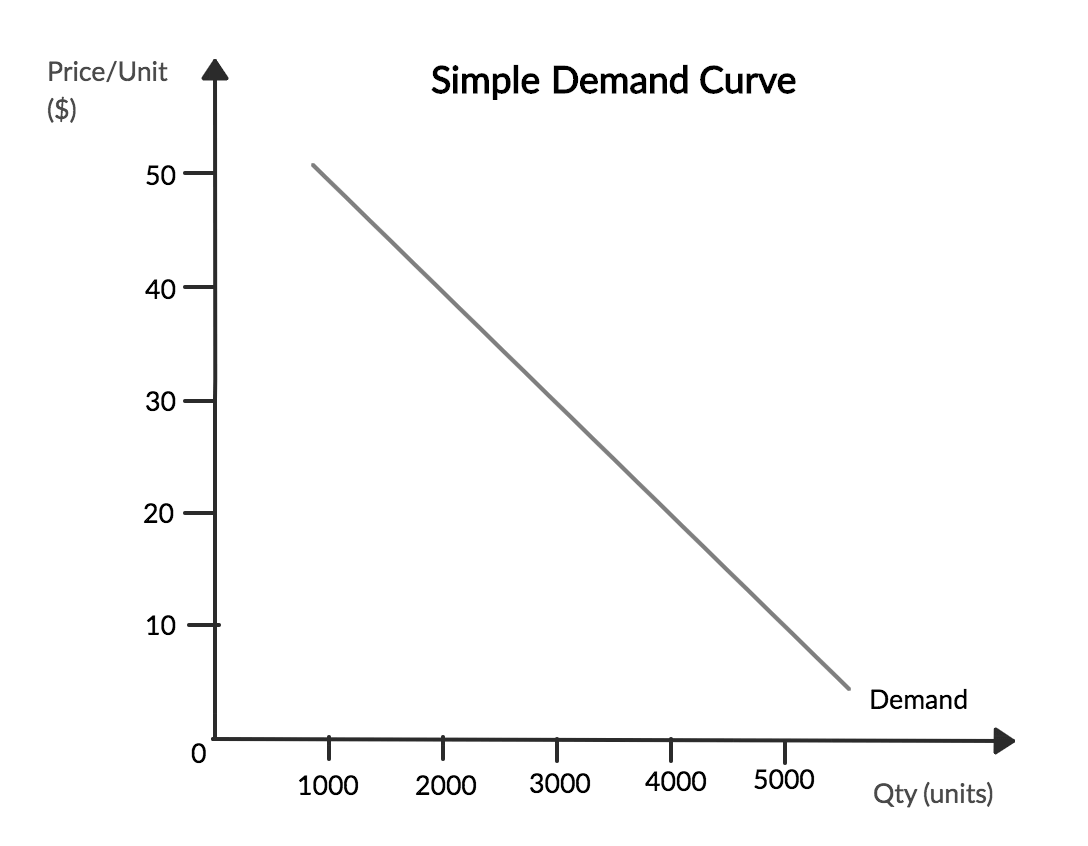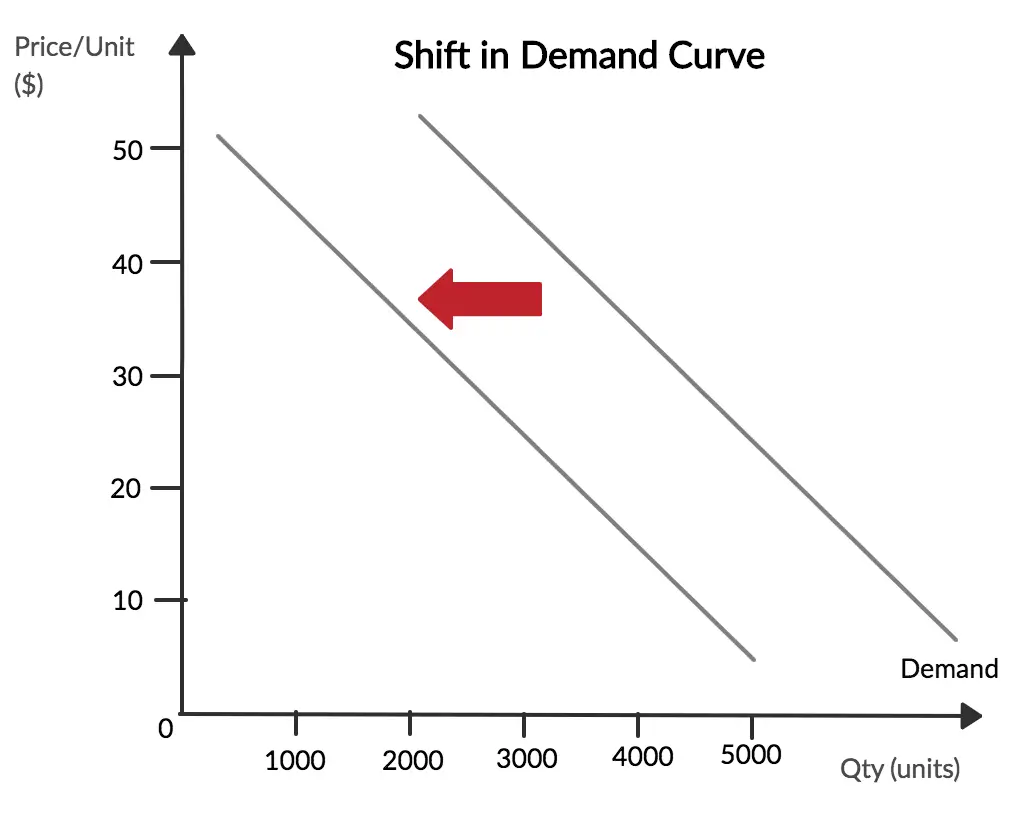Law of Demand: What it is, Examples & Diagram
What is Demand?
In economics, demand refers to how many people are willing and able to pay for a good at a specific price. This can increase when prices go down and more consumers are willing and able to afford it. Or, demand can go down when prices rise and the good becomes more expensive.
Demand naturally goes up and down as it interacts with supply and prices. For instance, Mr. Jefferies wants to buy a Ferrari, but he is unable to do so when the price is $300,000. Yet if the Ferrari was $100, he would most definitely want to buy one. In turn, Mr. Jefferies and many others would increase the demand as the price went down – which leads us onto the law of demand.
Key Points
- The Law of Demand states that when prices rise, demand declines – and when prices decline, demand rises as the good is cheaper.
- Diminishing marginal utility is a key part of demand. When consumers no longer receive utility from a purchase, further demand for the good stops.
- Demand can change due to factors such as – rising consumer incomes, changing trends, expectations of future prices, and substitute goods.
Law of Demand Definition
As with many products or services, businesses reduce prices in order to increase demand. Alternatively, they may increase prices to reduce demand. As these prices fluctuate, it has an impact on demand, which is known as the law of demand.
Demand reacts to price, but also supply. For example, too much supply makes the good plentiful, which can incentivize suppliers to reduce prices and increase demand to meet supply. At the same time, if there is insufficient supply to meet demand, then the supplier will raise prices in order to capture the consumer surplus. This will in turn incentivize an increase in production.
The law of demand is best understood with an example:
During the week, Bill’s Restaurant experiences low levels of demand. By contrast, at the weekend, the restaurant serves 500 customers a day, whilst only 100 during the week. Bill knows people do not want to eat so much during the week. With this knowledge, he therefore reduces the prices by 50 percent on weekdays to attract more demand and customers.
Customers are now more willing to go to Bill’s because it is much cheaper. Each customer values the product or service they receive differently – each consumer has a different willingness to pay. In turn, the lower the price, the bigger market can be targeted as more consumers are attracted.
Simply put, the law of demand explains the relationship between demand and prices.
The higher the price, the lower the demand. Not many people will buy a $20 hamburger. Increase the price to $50 and even fewer people will buy it – if any.
The lower the price, the higher the demand. Not many people will buy a Ferrari for $300,000. However, lower the price to $100 and the demand would sky-rocket.
Factors that affect Law of Demand
There are a number of factors which can affect the law of demand. Some examples include:
1. Consumer expectations about future income
When consumers expect a bonus, pay rise, or promotion, they may become more willing to increase spending to align with their new level of income. However, the opposite runs true if they expect a decrease in income. For instance, if there is a recession, they may anticipate redundancy or a potential loss of purchasing power. Therefore, they may reduce demand and spending.
2. Government Policies
Government plays a crucial role in affecting demand through the policies it makes. For example, taxes, subsidies, and regulations can all affect demand. Higher taxes make goods more expensive, whilst subsidies can make certain goods more affordable.
3. Seasonality
For certain goods, seasonality can be a huge factor affecting demand. For example, Christmas is a notably busy period as demand for gifts increases. There are also other seasonal trends such as clothing. Demand for warmer clothing such as coats and scarves tend to pick up during the autumn and winter months. By comparison, summer months tend to see an increase in demand for goods such as swim ware, or food products such as ice cream.
4. Advertising and Marketing
Good and effective advertising campaigns can influence consumer behavior and therefore increase demand for its goods. For some products, it may be to increase awareness and desire. Think small to medium firms that aren’t household names. By contrast, brands such as Apple use such campaigns to create awareness for their latest products. These will often lead to an increase in demand for their goods.
5. Demographics
Demographics plays a key role in demand. Characteristics such as age and gender often influence demand for certain goods. For example, an elderly population will have greater demand for healthcare goods. By comparison, a younger population may have a greater demand for goods such as clothing and entertainment.
Law of Demand Example
The law of demand is linked to diminishing marginal utility. For example, the consumer may value their first tub of ice cream at $5. Yet after eating that tub, they are unlikely to be willing to spend another $5 on a second tub. Demand and hence value tends to decline due to marginal utility.
We also have to consider elasticity of demand. For example, when a product has inelastic demand, the level of demand does not respond dramatically to changes in price. In other words, the price can double, yet just as many people will still want to buy the product.
We then have the opposite of inelastic demand – elastic demand. This is where demand is highly responsive to changes in price. Think of a loaf of bread. A small percentage change in the price may lead to a large decrease in demand as consumers flock to alternatives instead.
The law of demand works slightly differently in real life, but the fundamental law remains the same – prices go up, demand goes down. For inelastic goods, we may look to luxury products such as a Ferrari. A ‘small’ price increase of $10,000 is unlikely to put many off purchasing when the price is already $300,000. Yet increase the price by $200,000 and many will start to look elsewhere. So even though the good is inelastic, the law of demand still applies – just not as strongly.
Elastic goods provide a better example of the law of demand in action. Such goods are highly responsive to changes in price – exactly what the law of demand dictates. So think of many goods in the supermarket – bread, ice-cream, butter, or cereal. Essentially, any good that has many substitutes and a low price range is likely to be highly elastic. So when the price of a butter brand goes up by $0.50, consumers may opt for a cheaper brand instead.
The Law of Demand Curve
The demand curve shows the relationship solely between demand and prices. As we can see from the graph below: as prices go lower, demand increases – thereby illustrating the law of demand. For example, a laptop is half price in the Black Friday sale. It may now be cheap enough to attract thousands of additional consumers at the lower price.

The demand curve shows the direct relationship between demand and prices. This is known as the law of demand which states that when prices go up, demand falls and when prices go down, demand increases. Some items are more sensitive to price changes than others, which comes under the term ‘elasticity of demand’. Put simply, this is where some goods react differently to price changes. Yet the law of demand still remains – prices go up, demand falls, and when prices go down, demand increases.
Shifts in the Demand Curve
Sometimes the demand curve can shift, which is where prices stay the same, but demand falls. For example, McDonald’s may still be selling a Big Mac for $10, but within a year, they are serving fewer to customers. This is usually the result of five factors:
- Consumers income
- Changing trends or tastes
- Expectations of future prices/supply/ or needs
- Substitute goods fall in price
- Fall in potential buyers

1. Consumers Income
When prices remain the same, demand can fall if consumers start earning more or less money. For example, if consumers start earning more, they may switch to superior products. They may switch from eating McDonald’s to eating out at a Steakhouse. By contrast, if consumer income decreases, they may switch the other way. So consumers who used to eat Steak and Fries now switch to eating McDonald’s. This is where the demand curve moves forward.
2. Consumer Trends
Consumer trends can alter demand whether consumers get bored with existing products, or a negative fault may become apparent for the existing product. For example, consumers may be made aware that Phone A has been known to catch fire.
Even though prices have not fallen, the demand for it may shift to the left and therefore fall. There may also be a new and superior product that has recently been released. The latest Phone B may cause demand for Phone A to decline, even though it’s sold at the same price. In order to maintain demand, this is why many phone companies start reducing their prices after some time.
3. Expectations of Future Price
Consumers may hold back on their purchases if they expect future prices to be lower, or even higher. For example, consumers may reduce demand in the run-up to Black Friday.
They may expect the TV they have always wanted will be on offer in the sale. In the short term, the demand curve may shift to the left – which is where demand falls despite prices being the same. However, it can also shift to the right. For instance, if consumers expect prices to rise, they may stock up in the short-term – thereby increasing demand.
4. Price of Substitutes
You are walking down the high street for your lunch. McDonald’s is offering a Big Mac for $10 as usual. Burger King is offering their Whopper for $10 as usual. Come the next day, McDonald’s is still offering a Big Mac for $10. However, Burger King has reduced its Whopper to $8. This can reduce demand, and therefore shift the demand curve left for McDonald’s Big Mac.
5. Number of Potential Buyers
This usually happens over a longer time period. People may move out or into the area. More people moving closer may increase demand without prices increasing or decreasing, which shifts the demand curve to the right. Perhaps, with the case of smartphones, people start gaining knowledge of how to use them and their benefits. This can also increase demand and shift the demand curve to the right.
What is Aggregate Demand
We have looked at what demand is. We have looked at what the demand curve is. And we have looked at what can cause shifts in demand.
We will now look at what the economic term ‘aggregate demand’ means.
Simply put, aggregate demand is total demand or the amount everyone in the country wants. This is a rather pretentious terminology used by economists. It is simpler to call it ‘total demand’, but in economics, it is referred to as ‘aggregate demand’.
FAQs on the Law of Demand
The basics principle of the law of demand is that demand reacts to price. When prices rise, demand falls as consumers no longer wish to buy as they perceive it as too expensive. Alternatively, when prices fall, demand increases as the good now captures more consumers who previously thought the good was not worth the price.
The law of demand is important as it is the key cornerstone to economic thinking – along with the law of supply. As economists, we apply the law of demand and supply to almost every good. This also helps policy makers and businesses to decide on what policies or prices could be used to create more demand.
The law of demand dictates that when prices go up, demand goes down – and when prices go down, demand goes up. For instance, a baker sells bread rolls for $1 each. They sell 50 each day at that price. However, when the baker decides to increase to price to $1.20 – they only sell 40.
About Paul
Paul Boyce is an economics editor with over 10 years experience in the industry. Currently working as a consultant within the financial services sector, Paul is the CEO and chief editor of BoyceWire. He has written publications for FEE, the Mises Institute, and many others.

Further Reading
 Why is Communism Bad - Critics of communism argue that it often leads to authoritarianism, inefficiency, lack of incentives, and human rights abuses, making it…
Why is Communism Bad - Critics of communism argue that it often leads to authoritarianism, inefficiency, lack of incentives, and human rights abuses, making it…  Mercantilism: Definition, Characteristics & Examples - Mercantilism is an economic policy whereby a nation aims to maximize exports and minimize the imports.
Mercantilism: Definition, Characteristics & Examples - Mercantilism is an economic policy whereby a nation aims to maximize exports and minimize the imports. 